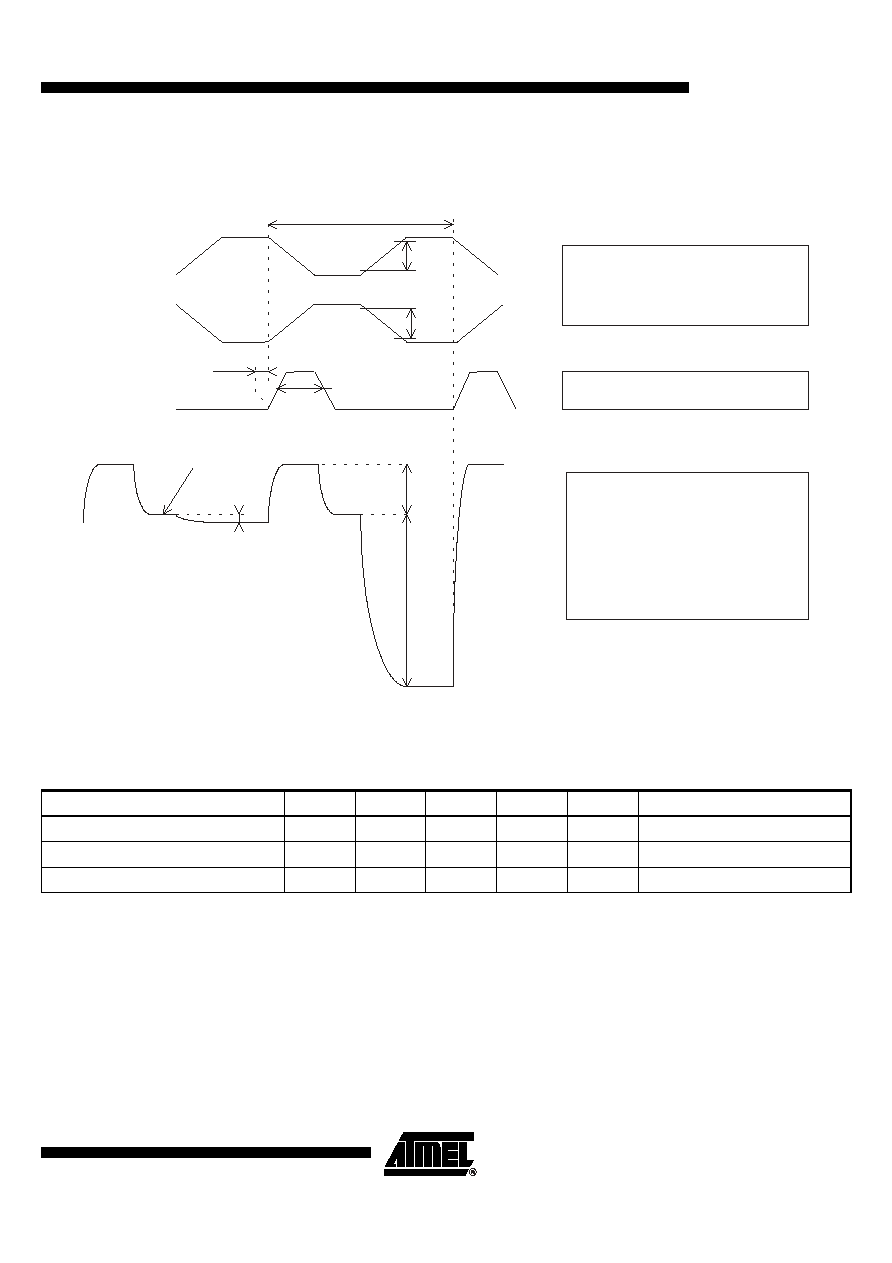
1
Features
·
Data Rate up to 50 MHz (2 Outputs at 25 MHz Each)
·
Pixel Size: 10 µm x 10 µm (10 µm Pitch)
·
300 to 1100 nm Spectral Range
·
High Sensitivity and Lag Free Photodiodes
·
Very Low Noise (30 pJ/cm
2
Noise Equivalent Illumination)
·
Antiblooming
·
Exposure Control
·
20-lead 0.4" DIL Package
Description
TH7815 linear arrays are based on Atmel's most recent technology in terms of design
and performance. The flexibility and performance of these devices provide the oppor-
tunity to use them in most vision systems for industrial applications (web inspection,
process control, sorting and inspection of various parts), document scanning up to
200 dpi and metrology.
Pin Identification
All pins must be connected.
Pin Number
Symbol
Function
4, 17
VDD1,2
Output Amplifiers Drain Supply
3, 18
VOS1,2
Video Outputs
5
VS
Output Amplifiers Substate Bias
20
VDR
Reset Drain Supply
2
VGS
Output Gate Bias
14
L1
Readout Register Clocks
13
L2
15
R
Reset Clock
10
A
Antiblooming Gate Bias/Clock
7
VA
Antiblooming Drain Bias
8
VST
Storage Gate Bias
11
P
Transfer Gate Clock
1, 6, 9, 12, 16, 19
VSS
Ground, Optical Grounding (Internally Connected)
1
2
3
4
5
6
7
8
9
10
20
19
18
17
16
15
14
13
12
11
VSS
VGS
VOS1
VDD1
VS
VSS
VA
VST
VSS
A
VDR
VSS
VOS2
VDDR
VSS
R
L1
L2
VSSP
TH7815ACC
50 MHz 4096
Linear CCDs
TH7815ACC
Rev. 1995AIMAGE04/02

2
TH7815ACC
1995AIMAGE04/02
Operating
Precautions
Shorting the video outputs to any other pin, even temporarily, can permanently damage
the on-chip output amplifier.
Absolute Maximum Ratings*
Storage Temperature Range ......................... -55°C to +150°C
Note:
Stresses above those listed under absolute maximum
ratings may cause permanent device failure. Func-
tionally at or above these limits is not implied.
Exposure to absolute maximum ratings for extended
periods may affect device reliability.
Operating range defines the limits within
which the functionality is guaranteed.
Electrical limits of applied signals are given
in operating conditions section.
Operating Temperature Range........................ -40°C to +85°C
Thermal Cycling........................................................ 15°C/min
Maximum Applied Voltages:
· Pins 2, 8, 10, 11, 13, 14, 15 ................................. -0.3 to 15V
· Pins 4, 5, 7, 17, 20 .............................................. -0.3 to 16V
· Pins 1, 6, 9, 12, 16, 19 ........................................0V (ground)

3
TH7815ACC
1995AIMAGE04/02
Operating Conditions
Table 1. DC Characteristics
Parameter
Symbol
Value
Unit
Min.
Typ.
Max.
Output Amplifier Drain Supply
VDD1, VDD2
14.5
15
15.5
V
Storage Gate Bias
VST
2.2
2.4
2.6
V
Antiblooming Gate (See Pixel
Saturation Adjustment)
A
2
4
7
V
Reset Bias
VDR
13.5
14
14.5
V
Antiblooming Diode Bias
VA
14.5
15
15.5
V
Register Output Gate Bias
VGS
2.2
2.4
2.6
V
Output Amplifier Source Supply
VS
0
V
Ground
VSS
0
V
Table 2. Drive Clocks Characteristics
Parameter
Symbol
Value
Unit
Remarks
Min.
Typ.
Max.
Reset Gate
High Level
Low Level
R
8.5
-0.1
9
0
9.5
0.4
V
V
Clock Capacitance < 50 pF
Transfer Gate
High Level
Low Level
P
8.5
-0.1
9
0
9.5
0.4
V
V
Clock Capacitance < 200 pF
Readout Register Clocks
High Level
Low Level
L1, 2
8.5
-0.1
9
0
9.5
0.4
V
V
Maximum Readout Register
Frequency
F
H
10
25
MHz
200 pF
500 pF
460 pF
L1
L2

4
TH7815ACC
1995AIMAGE04/02
Timing Diagrams
The following diagram shows the general clocking scheme for TH7815ACC.
The line is composed as follows:
Postscan elements may be added in order to either increase the exposure time, or to
provide a voltage reference level.
Figure 1. Line Timing Diagram
The following diagram shows the timing for the transfer period:
Figure 2. Line Transfer Period
R clock may also be held in high state during line transfer period.
Synopsis
Number of Prescan
Pixels Per Output
Number of Useful
Pixels Per Output
Total Number of Pixels
Per Output
TH7815ACC
4
2048
2052
A
P
L1
L2
R
Line Period
Transfer Period
A
P
L1
L2
R
> 300 ns
> 10 ns
> 10 ns
first prescan pixel
(700 ns typ.)

5
TH7815ACC
1995AIMAGE04/02
The following diagram shows the detailed timing for the pixel readout:
Figure 3. Pixel Readout Timing Diagram
Exposure Time
Reduction
The TH7815ACC antiblooming structure provides an electronic shutter capability by
clocking phase
A during the line period. The timing diagram is described below:
L1
L2
R
10%
90%
90%
10%
tr
tf
Tpixel
0 ns
10 ns
50%
Video signal
Reset Feedthrough
Offset in darkness
VIDEO OUTPUTS
±
floating diode level
Duty cycle: 50%
±
10%
Crossover at 50%
±
10%
Rise and fall time
10 ns
Rise and fall time
8 ns
Video outputs are synchronous
Video signal occurs on
L2 falling edge
First useful pixel occurs on 5th
falling edge of
L2 after
P
Antiblooming Gate
A
Min.
Typ.
Max.
Unit
Clock Capacitance < 200 pF
High Level
8.5
9
9.5
V
Low Level Sets Saturation Level
Low Level
2
4
7
V
See Pixel Saturation Adjustment
Pulse Min.
200 ns




